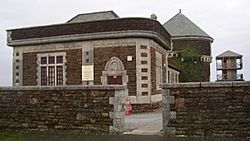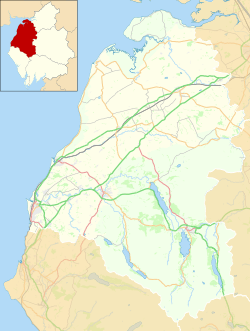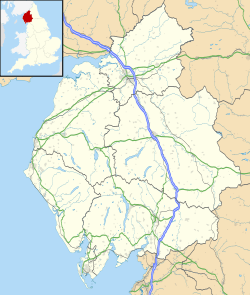Alauna (Maryport) facts for kids
Quick facts for kids Alauna |
|
|---|---|
| Cumbria, England | |

Senhouse Roman Museum, with its replica Roman watch-tower in the background.
|
|
| Coordinates | 54°43′15″N 3°29′38″W / 54.720936°N 3.493978°W |
Alauna was a castrum or fort built by the Roman Empire in ancient Britannia (which is now England). It was located on the coast, just north of the town of Maryport in Cumbria.
This Roman fort was connected by special Roman roads. One road led to another Roman fort called Derventio (near Papcastle). From there, another road went northeast to Luguvalium (Carlisle), which was an important Roman city.
In 2015, a project about Maryport's old monuments won a big award. It was named Research Project of the Year at the British Archaeology Awards.
Contents
What Was Alauna's Name?
Historians are quite sure that the Roman name for Maryport was Alauna. This name comes from a river. The Roman fort stood on a hill, north of the River Ellen.
The name Alauna is found in an old Roman book called the Ravenna Cosmography. Other old Roman travel guides, like the Antonine Itinerary, mention a fort called Alone. However, this Alone was probably not Maryport. It was likely a different fort near Kendal or Tebay.
Another Roman document, the Notitia Dignitatum, lists a fort called Alione. This fort was guarded by a group of soldiers called the Cohors III Nerviorum. Some experts think Alione might be the same as Alauna.
What Was the Fort Like?
The Alauna fort was built around the year 122 AD. Its main job was to be a command center and supply base. It helped protect the western end of Hadrian's Wall. This wall was built to keep out invaders from the north.
Alauna was one of several forts along the Cumbrian coast. These forts stopped enemies from going around Hadrian's Wall by crossing the Solway Firth. Today, you can still see many parts of the old Roman fort.
Scientists have used special tools to look underground. These tools showed that a large Roman town grew up around the fort. Digs have also found signs of an even older, bigger fort. This earlier fort was partly underneath the one we see today.
Exploring the Fort with Science
From 2000 to 2003, a team used special scientific methods to map the fort. They also mapped the vicus, which was the civilian town next to the fort. This was the largest survey of its kind on the northern Roman border.
The survey showed many layers of activity from different time periods. It even found a possible Roman port or walkway near the coast. Sadly, some of the fort's stones were taken to build other local buildings later on.
The vicus (civilian town) was very well preserved. It had a main road leading to what might have been a Roman trading center. The fields around the town were also big. They had small garden plots, some with buildings on them. The survey also found signs of an Iron Age settlement and buildings from the Middle Ages.
Museum and Roman Treasures
The land where the Roman fort stands has been owned by the Senhouse family since the 1500s. The main building on the site was once a naval drill hall. In 1990, it became the Senhouse Roman Museum.
The museum now holds all the amazing Roman items collected by the Senhouse family. These include many altars. More altars have been found at this site than anywhere else in Britain! People have been finding these treasures for hundreds of years.
The Roman Altars
The altars found at Alauna are made from local sandstone. Romans used them for special ceremonies, probably held every year. The words carved on the altars tell us a lot about the fort and the people who lived there.
One famous altar is now in the British Museum. It was dedicated by a man named Gaius Cornelius Peregrinus. He was a decurion (a town councilor) from Saldae (now Bejaia in Algeria). He was also the tribunus (military commander) of the soldiers stationed at the fort.
New digs starting in 2011 have taught us even more about these altars. Archaeologists like Ian Haynes and Tony Wilmott have been involved. Tony Wilmott even won an "Archaeologist of the Year" award in 2012.
We don't know exactly where the altars originally stood. But they were designed to be placed in rows. They might have been near a temple, and archaeologists have looked for signs of two temples.
In 2011, archaeologists re-examined a spot where 17 altars were found in pits back in 1870. They now believe the altars were reused as foundations for a later Roman building. This suggests that religious beliefs at Alauna changed over time during the Roman period.
Images for kids




